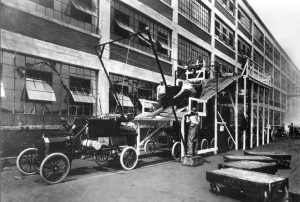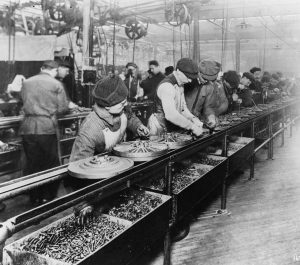Industrial Revolution (1800’s-1940’s)
26
Katy Boozer

Introduction
Imagine if automobiles were only owned by high class members of society, extremely highly-priced, and valued by only a small percentage of American society. This is what life was like the first few years of the 1900s. However, when 1913 rolled around, Henry Ford decided he was going to change the industry. Ford declared, “When I’m through, about everyone will have one” (“Ford’s Assembly Line Starts Rolling“, 2009). By December, the first automobile assembly line was implemented at the Ford Motor Company of Highland Park, Illinois (Figure 1). The assembly line was a pivotal invention of the Industrial Revolution that exponentially developed the automobile industry starting in the early 1900’s with its impact still present today. The assembly line opened the door for more technology, evolved over time to improve efficiency and positively affected society.
EVOLUTION OF FORD’S MODEL-T
The assembly line was a new technological idea that opened up the door for future technology by vastly cutting down the production time of automobiles in the early 1900’s. Before the creation of the line, Ford’s factories ran in a simple, base-level way. According to a History.com article titled, “Ford’s Assembly Line Starts Rolling,” factory workers were stationed throughout the factory assembling parts spread out on the floor. As the Model N, the initial version of the Model T, was assembled, it was pushed down the line as workers added on their assembled parts along the way (2009). Shortly thereafter, Ford’s methods developed slightly when the assembly of the Model T included 84 detailed steps. As shown in Figure 2, workers were explicitly trained on their specific step (“Ford’s Assembly Line Starts Rolling“, 2009). After many years of attempting to further develop his automobile production, Ford’s goal was to create a method of production that cut down both the cost and production time of the Model-T automobile (Wilson, 2013). Ford also intended to lower the price of his automobile for it to be available to a larger majority of society, rather than solely the high class. With many goals in mind, he discovered the assembly line: a series of workers and machinery in a formative order that assembled automobile parts in an extremely timely, effective manner. The implementation of the assembly line decreased the time it took to produce the Model-T from over 12 hours to only two and a half hours (“Ford’s Assembly Line Starts Rolling“, 2009). However, when implementing machinery to cut production time, this led to a vast decrease in the number of needed factory workers. “I am proud he was able to bring the freedom of mobility to millions by making cars affordable to families and that his vision of serving people still drives everything we do today,” said Ford Executive Chairman Bill Ford (“Innovation: 100 Years,” 2015). By producing a much higher quantity of automobiles at a much lower cost, this permitted the Ford Motor Company to supply the Model-T at only $300 instead of $850 (“Innovation: 100 Years,” 2015). As time went on, production continued to increase, and more Americans were able to obtain the once idolized possession. A New York newspaper, titled Negro World (1931), published a news article on April 25, 1931, stating “Early this morning in the assembly line at the River Rouge plant of the Ford Motor Company, a mechanic stepped on the starter of the twenty millionth Ford car” (p. 4).

By decreasing the production time and cost of the Model-T, more time and money was dedicated to advancing the technology of its time to begin its transition into the technology present today. After only eighteen years, the automobile transformed from solely a high-class novelty to a common, valued possession driven on the streets by middle-class families, and it opened the door for more technology to come.
SUCCESS OF THE FORD MOTOR COMPANY
Over 100 years later, it is not a surprise that the assembly line is still implemented not only in the Ford Motor Company but in automobile manufacturers across the country. While it is present today, Figure 3 displays the many alterations that have been made to transform the line in the Chicago plant into an even more complex piece of technology (New Cars, 2015). According to Ford Motor Company’s published article called “100 Years of the Moving Assembly Line,” updated technology now allows the Ford business to produce 16 cars every minute, completing 6 million in total in 2013 alone (“Innovation: 100 Years,” 2015). This quick production of automobiles allows Ford Motor Company to remain towards the top of the automobile industry today. Yet, while they are still towards the top, the company is still making strides to remain leading the industry via additional technological advances. For example, the Ford Motor Company (“Innovation: 100 Years,” 2015) has recently released that “Ford engineers are developing a highly flexible, first-of-its-kind, patented technology to rapidly form sheet-metal parts for low-volume production use.” Referred to as Ford Freeform Fabrication Technology, or F3T, this new advance plans to drop the delivery time for metal prototypes from two to six months to within three business days. (“Innovation: 100 Years,” 2015). The Ford Company began using a form of computer simulations reflecting both the economy and the company overall to determine the best possible technological advances and how to improved quality for consumers and revenue for the business (“Innovation: 100 Years,” 2015). The information collected from the computer simulations improved the assembly line by making the line more compatible with human physicality and size. In addition, the assembly line was geared towards minimizing environmental harm. According to D.E. Nye, highly regarded author of America’s Assembly Line, Ford’s assembly line was implemented with energy-saving features, and many factories have even been rebuilt to use an abundance of natural light (Nye, 2013). Over the hundred years since Henry Ford first implemented his idea of a moving assembly line, the Ford Motor Company has continued to make great strides in further developing Ford’s initial assembly line into a powerful force in the automobile industry.
Figure 3: Ford Factory – Chicago provides footage of the present-day manufacturing line in Ford Motor Company’s Chicago production plant. “Ford Factory – Chicago” by New Cars 2015, YouTube is in the Public Domain, CC0.
AMERICAN CRITICISMS
While the innovation and advances of the assembly line had many positive outcomes, it was often criticized because of its few negative outcomes. With the implementation of additional technology throughout the assembly line, necessary for human workers began to decrease. Additionally, anytime an aspect of the line was broken or removed, workers on that part of the line were often laid off (Nye, 2013). The initial benefits of increasing production and decreasing costs were highly praised by Americans, but when the cost of exploitation of workers and mass unemployment followed, people were not quite as sold on the idea of assembly lines. “You’ve got to work like hell in Ford’s. From the time you become a number in the morning until the bell rings for quitting time you have to keep at it. You can’t let up. You’ve got to get out the production and if you can’t get it out, you get out,” protested a young college student employed along the assembly line (Nye, 2013, p. 102). An additional critique of the implementation of the assembly line came from the factory workers’ perspective. According to David Nye, “Workers benefited from the short hours, higher wages, and falling consumer prices, but they worried about the loss of freedom on the shop floor, about endless repetition of the same movements for eight hours, and about jobs that deadened the soul” (Nye, 2013, p. 102). While the implementation of the assembly line in automobile production was highly praised in the beginning, it was quickly censured by many Americans.
ASSEMBLY LINE’S EFFECTS ON SOCIETY
After years of implementing the assembly line at the Ford Motor Company, the innovation spread vastly around the country. Not only were assembly lines executed in car manufacturing, assembly lines were present in manufacturers of many expertise. According to a NY Daily News article titled Ford’s assembly line turns 100: How it changed society, “Other industries soon adopted the innovation and today, everything from cereal to caskets is made on assembly lines” (“Ford’s Assembly Line Turns 100,” 2013). As assembly lines were implemented in industries across America, society was greatly affected by the new means of technological production. Assembly lines led to corporations lowering the costs of their goods and producing more high-quality products (“Ford’s Assembly Line Turns 100,” 2013). This in return generated higher profit for American businesses, leading to an increase in wages for succeeding company’s workers. Referring to Florin Bonciu, respected author of the published article Evaluation of the Impact of the 4th Industrial Revolution on the Labor Market, the assembly line was one of many forms of technology that appeared during the Industrial Revolution that proved the positive effects of technology on society. The success of rising technology manufacturers during this time created an abundance of jobs while decreasing physical labor, as well as drastically increasing output productivity (Bonciu, 2017). Overall, the widespread use of assembly lines in American manufacturing corporations has greatly influenced society in a positive way.
CONCLUSION
As the years have gone by, American society has vastly changed. One thing that remains is the ever-changing technology that is present in Americans’ daily lives. In 1913, Henry Ford’s assembly line sparked a pivotal change in the production of automobiles. The development of the assembly line led to many years of successful businesses, economic improvement, and scientific change. Henry Ford’s goal was to increase the accessibility of automobiles to a greater quantity of Americans; little did he know the assembly line would change the way of life for countless generations to come.
Chapter Questions
- True or False: Henry Ford first implemented the automobile assembly line in 1913.
- Multiple Choice: Which of the following was not one of Henry Ford’s goals in mind when he developed the assembly line?
A) Make automobiles more accessible for a larger majority of Americans
B) Cut down the price of the Model T
C) Decrease automobile production time
D) Provide automobiles only to the high-class members of society - Short Response: How did the implementation of Henry Ford’s assembly line affect Ford Motor Company’s production time for the Model-T? Why does this change in production time matter?
REFERENCES
Bonciu, F. (2017). Evaluation of the Impact of the 4th Industrial Revolution on the Labor Market. Romanian Economic and Business Review, 12(2), 7-16. Retrieved from http://libproxy.clemson.edu/login?url=https://search-proquest-com.libproxy.clemson.edu/docview/2049663014?accountid=6167
“Ford’s Assembly Line Starts Rolling.” (2009, November 13). Retrieved from https://www.history.com/this-day-in-history/fords-assembly-line-starts-rolling.
Ford’s Assembly Line Turns 100: How it changed society. (2013, October 7). Retrieved from https://www.nydailynews.com/autos/ford-assembly-line-turns-100-changed-society-article-1.1478331.
Innovation: 100 Years of the Moving Assembly Line: Ford Motor Company. (2015). Retrieved from https://corporate.ford.com/articles/history/100-years-moving-assembly-line.html.
“Henry Ford at Wheel of 20,000,000th Car”, 25 Apr. 1931, p. 4. Readex: America’s Historical Newspapers, infoweb.newsbank.com/apps/readex/doc?p=EANX&docref=image/v2:158A36FC0DDC4164@EANX-15A0AAA6683C9920@2426457-159C0F86AE8C0018@3.. Accessed 25 Nov. 2019.
New Cars 2015. (2015, March 16). Ford Factory – Chicago [Video file]. Retrieved from https://www.youtube.com/watch?v=NgTXEV4aIEM.
Nye, D. E. (2013). America’s Assembly Line. Cambridge, Mass: The MIT Press. Retrieved from http://search.ebscohost.com.libproxy.clemson.edu/login.aspx?direct=true&db=e000xna&AN=543922
Wilson, J. M. (2013, September 17). Henry Ford vs. Assembly Line Balancing. Retrieved from https://www.tandfonline.com/doi/full/10.1080/00207543.2013.836616
FIGURES
Figure 1: “A-line1913” by Wikimedia Commons is in the Public Domain.
Figure 2: “Ford assembly line – 1913” by Wikimedia Commons is in the Public Domain.
Figure 3: “Ford Factory – Chicago” by New Cars 2015, YouTube is in the Public Domain, CC0.
